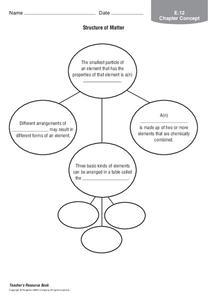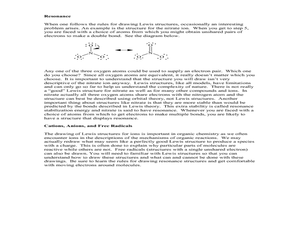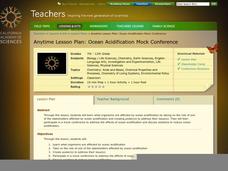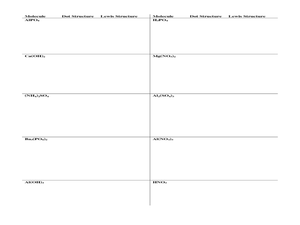Curated OER
Ionic Bonding
In this ionic bonding worksheet, students observe diagrams about ionic bonds and crystal formation. They answer 37 short answer questions about the properties of monatomic ions, polytomic ions and write correct formulas.
Curated OER
Combining Atoms
In this atoms worksheet, students explore the different types of bonds, name compounds, and determine charges of molecules. This worksheet has 8 true or false, 9 fill in the blank, and 5 short answer questions.
Curated OER
Combination of Atoms
In this atoms worksheet, students review protons, neutrons, electrons, molecules, compounds, and ions. This worksheet has 10 fill in the blank and 3 problems to solve.
Curated OER
Structure of Matter
In this matter worksheet, students review the structure of matter including elements, atoms, and the periodic table. This worksheet is a graphic organizer.
Royal Society of Chemistry
Shapes of Molecules—Distortion from the Pure Geometry
Ready to introduce the realities of molecular geometry to chemistry pupils? Use a logic-based interactive! Perfect as individual practice, the puzzles explore the bond angles and repulsions present in three common molecular shapes.
Curated OER
Extracting Oxygen from Moon Rocks
In this extracting oxygen from moon rocks activity, students read about the need for oxygen for lunar colonists. Students solve 2 problems about the lunar mineral ilmenite which contains oxygen and other elements. They find the molar...
Curated OER
Drawing Lewis Structures
In this drawing Lewis structures worksheet, students read about the 5 steps taken to draw Lewis structures for atoms and molecules. These include identifying the valence electrons, placing pairs of electrons between atoms to be bonded,...
Curated OER
Charge and Electricity
In this charge and electricity worksheet, students read about electric charges and how they are created in atoms. They also read about the unit of charge, called the Coulomb, conductors, and insulators. Emerging electricians match 11...
California Academy of Science
Ocean Acidification Mock Conference
In a comprehensive role playing activity, teens play the parts of different stakeholders in the realm of acidic oceans. They research, debate, and create a presentation from the perspective of either ocean organisms, the fishing...
Curated OER
Final Worksheet
Students will review a semesters worth of material on this final chemistry review. Information ranges from naming isotopes to pH and molarity.
Curated OER
Polymers Lab: Bouncy Ball and Slime
Eighth graders investigate chemical reactions to produce polymers. In this polymers lesson plan, 8th graders experiment with sodium silicate and ethyl alcohol to make a polymer. They also experiment with borax and glue to make a polymer....
Curated OER
Chemistry Midterm Topic Review
In this chemistry review learning exercise, students answer and solve 95 questions about chemical reactions, hydrocarbons, functional groups, moles, acids and bases and solutions.
Curated OER
Jeopardy 8th Grade (Science)
There are so many topics touched upon in this Jeopardy-style science game, that it is difficult to classify! The categories include electricity, matter, ecology, earth and space, and scientific investigation. This would best be used at...
Curated OER
Atomic Structure and Ionic Bonding (A Visual Approach)
Using toothpicks, marshmallows, and round colored sticky dots, physical science enthusiasts build models of an atomic nucleus. In this eighth grade chemistry lesson plan, they play an atom-naming game with the models that they have...
National Institute of Open Schooling
Chemical Arithmetics
Substances with the same empirical and molecular formula must be differentiated by their structural formula. Part two in a series of 36 has pupils using chemical formulas to calculate how much of a compound is present in a given...
Curated OER
The Nature of Salt
High schoolers record information from the periodic table for sodium and chloride. They determine whether salts are molecular or ionic compounds, along with sodium chloride's molecular weight, and relative weights
Curated OER
Synthesis Reactions
Two examples are displayed in graphic form, demonstrating to your young chemists how synthesis reactions work. This is not a full presentation, but rather just a couple of slides. Don't let its brevity cause you to disregard its value,...
Curated OER
Atomic Structure
The first nine slides visit the history of our understanding of atoms. The next several outline the structure of atoms. Subatomic particles, electron configuration, and diagramming methods are introduced. This is a neatly organized...
Science Geek
Periodic Trends
If your pupils think Um is the element of confusion, this presentation on period trends can only help. It covers the patterns for atomic radii, ionization energy, and electronegativity across a period and down a group.
Curated OER
Relative Mass Formula, Atomic Formula, and Empirical Formula
After giving the definitions of the different compound terms and formulas, equations are provided to teach your chemists to calculate different values. Relative formula mass, atomic mass, and empirical mass are shown and explained with...
Curated OER
Covalent and Ionic Bonding:Electron Dot Structures with Ionic Notation
After drawing the valence electron distribution of 13 basic elements, there are spaces to draw 18 more complicated molecules. For each molecule, there is space for a Dot structure and Lewis structure that best describes the distribution...
Curated OER
Covalent Bonding
Using chlorine as the model to demonstrate the structures and representations, this PowerPoint clearly labels and details the main atomic structures and reasons for bonding. The electrons in the outer shell are diagramed and then the...
Curated OER
Interpreting Chemical Formulas
In this chemical formulas activity, students practice naming molecular compounds by their formulas and determine if a gas is a compound or an element. This activity has 13 fill in the blank questions.
Curated OER
Water
In this water instructional activity, students compare and contrast elements and compounds. Students define chemical symbols, chemical formulas, and chemical properties. This instructional activity has 19 short answer questions.

























